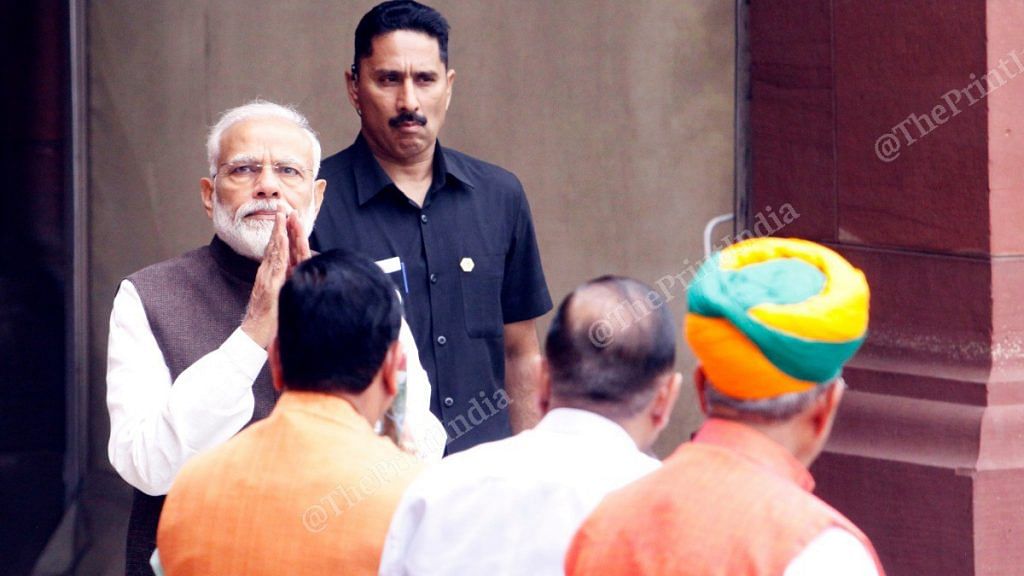An odd quandary stares at Narendra Modi. The Prime Minister, used to being solely credited for the Bharatiya Janata Party’s election wins one after another, may soon have fresh competition in winnable, popular leaders in the BJP. The Election Commission has announced the schedule for assembly elections in Maharashtra and Haryana – both the states where the BJP is in power and has a good shot at coming back. If its respective chief ministers, Devendra Fadnavis and Manohar Lal Khattar, are able to deliver victories without much help from the prime minister, then it could mean Modi can no longer claim credit for all of the BJP’s poll successes.
Modi has unequivocally established himself as the vote-catcher’ of the Bharatiya Janata Party (BJP), the only face it can rely on for electoral hits in the last five years. The invincible Modi certainly won’t want to let any election slip. But the emergence of strong state leaders who could hold their turf without him doing the heavy-lifting doesn’t bode well for him either.
The trend so far
Modi came to power with a handsome mandate in the 2014 Lok Sabha election, with the BJP winning 282 of 543 Lok Sabha seats. Obviously, all credit went to the former Gujarat chief minister whose ‘wave’ managed to catapult a majority win for a single political party after decades. Since then, all assembly election results too have highlighted a certain trend.
States where Modi was the main face throughout the election campaign, the BJP pulled off big, even miraculous, victories. For instance, the 2018 win in Tripura. The state was a Left bastion of the Left with the BJP without any base. The 2016 Assam election was also scripted with Modi as the hero, yet another state where the BJP stormed to power for the first time.
Uttar Pradesh in 2017 became another instance of a massive BJP victory following an election fought only, and only, in Modi’s name, with party president Amit Shah’s ground strategy providing a solid base. Voters who supported the BJP did so for Modi, with many even unsure of who their immediate candidates were.
Also read: How BJP is making Article 370 the focal point of its Maharashtra poll campaign
The 2017 Gujarat elections did have Chief Minister Vijay Rupani at the helm, but there is little doubt it was Modi who held sway on his home turf all the way.
Delhi 2015, on the other hand, was a disaster. The party decided to project Kiran Bedi as its candidate for chief minister and lost miserably. Many in the party privately said if that poll had been fought with Modi as the face, the BJP would have had a better shot – if not at winning, then at least at losing more respectably. In the Karnataka election last summer, the BJP may have emerged as the single-largest party but could not touch the magic number, doing so only a year later riding on defections and underhand tactics.
The most telling, however, were the elections in Madhya Pradesh, Rajasthan and Chhattisgarh – all held in the winter just before the 2019 Lok Sabha election. In all three states, the BJP had strong regional satraps – Shivraj Singh Chouhan, Vasundhara Raje, and Raman Singh. None of them were first-time chief ministers; all three had a strong mass base and hold over party organisations. They were powerful leaders in their own right and the elections carried their distinctive stamps.
The BJP went on to lose all three elections in varying degrees – a neck and neck fight in Madhya Pradesh, a better-than-expected performance in Rajasthan, and an absolute rout in Chhattisgarh. Many analysts observed at that time that Modi wasn’t investing all his energy into these state campaigns. With three of the BJP’s most powerful and influential leaders failing to deliver, Modi’s image as the party’s sole vote-catcher was further cemented.
Also read: BJP is confident, Shiv Sena aggressive as Maharashtra assembly poll countdown begins
What Haryana/Maharashtra wins would mean
What the BJP has witnessed in the last few years is that no big leader – national or otherwise – can match Modi’s prowess in winning votes. Devendra Fadnavis and Manohar Lal Khattar will not be anywhere close to challenging Modi even with impressive wins. But it will be a sign that the BJP has able regional leaders worth their salt and Modi cannot continue to take credit for all wins.
There’s also the question of scope for the gen-next to groom themselves under Modi-Amit Shah’s shadow. The 49-year-old Fadnavis is articulate, successful, carries a strong development image, holds the ability to govern well and manage crisis, and, most importantly, has roots in the Rashtriya Swayamsevak Sangh (RSS). A second term as chief minister – especially if the victory is in his name – will add to this young BJP leader’s future prospects of growing nationally.
This isn’t to say that Modi will not be crucial to the BJP’s campaign in Maharashtra and Haryana, or that Amit Shah’s strategy will not provide the much-needed backbone. But if the BJP wins these two states, a band of winnable, next-generation mass leaders will emerge – something that has been missing during Modi’s rise in the party since he became prime minister in the summer of 2014.
